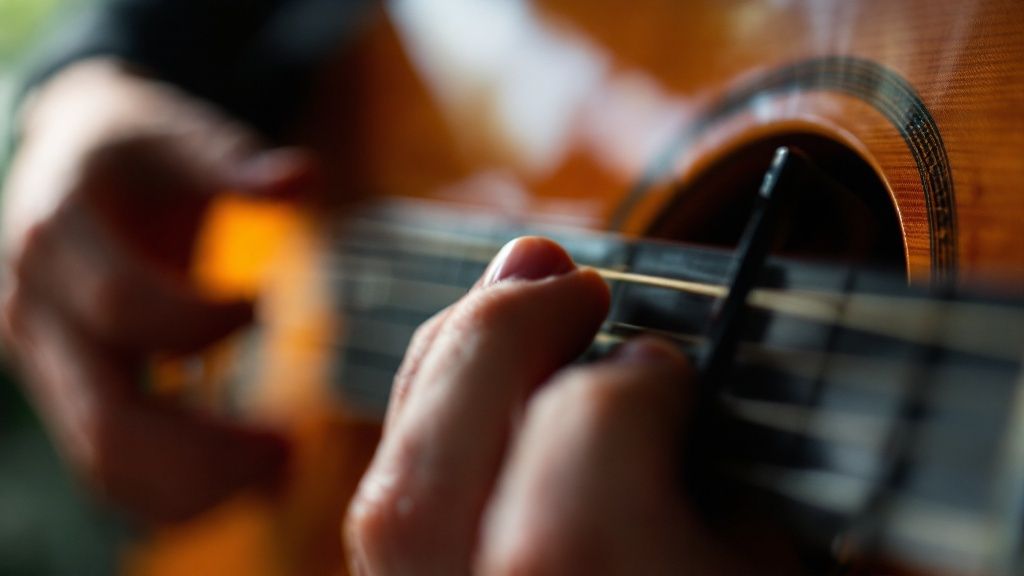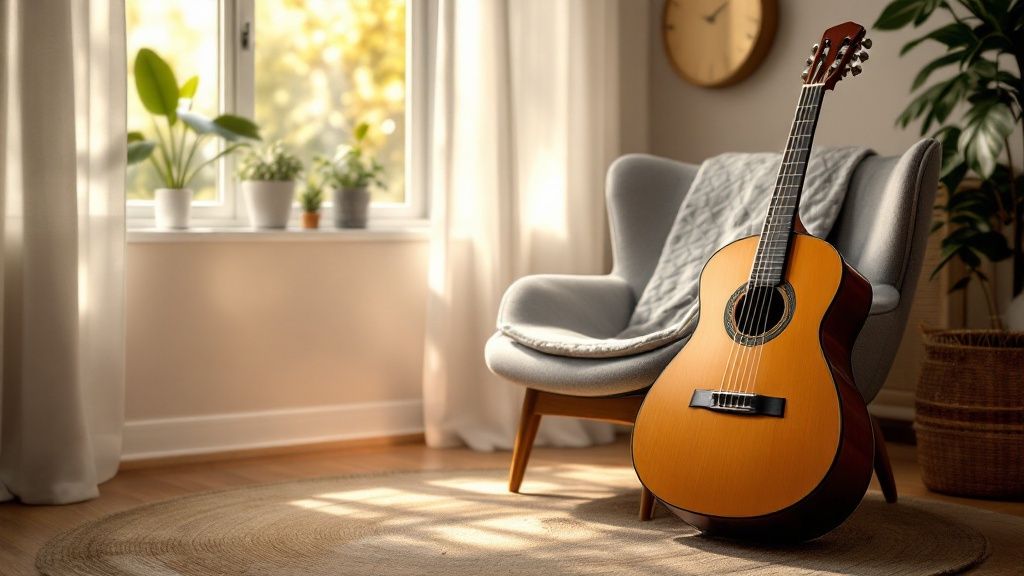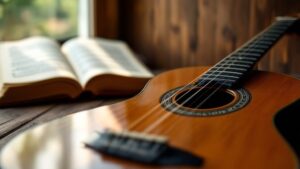Understanding the Classical Guitar Legacy

The classical guitar has a rich history that spans centuries. Learning about this musical journey adds meaning and context to any student's experience with the instrument. By exploring how the classical guitar developed over time, students gain a deeper connection to the music they create.
The Rise of the Classical Guitar
The modern classical guitar emerged gradually from earlier stringed instruments. During the 19th century, major design improvements transformed it into the instrument we know today. These advances created new possibilities for sound and technique that shaped classical guitar education.
One key innovation was the development of fan bracing inside the guitar body. This structural change dramatically improved the instrument's volume and tonal range, making it suitable for concert performances. The classical guitar didn't gain widespread recognition in art music until the early 20th century, largely due to the efforts of Andrés Segovia. His performances and advocacy elevated the guitar's status, encouraging composers to write new works specifically for the instrument. Discover more insights about the classical guitar.
The Segovia Effect and Modern Classical Guitar Teaching
Andrés Segovia's influence went far beyond his performances. He established many of the teaching methods still used today and created a systematic approach to classical guitar instruction. His work laid the foundation for how the instrument is taught in music schools worldwide.
Thanks to Segovia's efforts, the classical guitar found its place in formal music education programs. This opened new doors for students to study the instrument in conservatories and universities. His legacy continues to inspire new generations of guitarists.
Connecting the Past to Your Learning Experience
Understanding the classical guitar's history enriches the learning process in several ways:
- It provides context for traditional techniques
- It helps students appreciate the instrument's evolution
- It adds meaning to the classical repertoire
- It motivates practice with historical perspective
This historical awareness transforms routine practice into a deeper musical journey. When students understand why certain techniques developed and how master guitarists refined them over time, their own practice becomes more purposeful. Knowledge of the classical guitar's past creates a richer, more rewarding learning experience.
Building Your Essential Classical Guitar Foundation

Starting to learn classical guitar begins with choosing the right first instrument. While you don't need an expensive guitar as a beginner, look for one that feels comfortable and produces good sound. Many students do well with a nylon-string guitar, which offers a gentler feel and richer tone that works perfectly for classical music.
Establishing Proper Posture and Healthy Habits
Good posture makes all the difference in playing well and staying injury-free. Keep your back straight and use a footstool to raise your left leg – this creates a stable position for holding the guitar. Getting these basics right from the start helps prevent strain and builds good habits that will serve you well as you progress.
Essential Accessories and Their Importance
While music stores offer many add-ons, focus on these key items that truly help your practice:
- Footstool or Guitar Support: Keeps you comfortable and properly positioned
- Clip-On Tuner: Helps maintain correct pitch, though learning to tune by ear develops your musical ear
- Metronome: Builds solid rhythm and timing skills
Navigating Common Beginner Challenges
Take time to find the right strings and develop good maintenance habits. Try different nylon string tensions to discover what feels and sounds best to you. Make it a habit to wipe down your guitar with a soft cloth after playing – this simple step keeps your instrument in great shape and protects its finish.
These fundamental elements create a strong base for your classical guitar journey, helping you work through early challenges while building skills that last. With these basics in place, you're ready to grow and enjoy making music. For more guidance and resources, check out Tune Tailors.
Leveraging Modern Learning Methods for Classical Success
Classical guitar instruction has taken exciting new directions while staying true to core principles. Students now have access to both traditional teaching methods and new learning tools that can speed up their progress and development.
Combining In-Person Lessons with Digital Resources
Working with a skilled instructor in person remains vital for building proper technique. Your teacher provides hands-on guidance for posture, fingering, and the subtle nuances that define classical guitar. However, adding digital tools between lessons can boost your learning significantly.
Many online platforms now offer extensive sheet music libraries and technique-focused video lessons. Simple tools like metronome apps help develop rock-solid timing, while tuning software trains your ear. These resources let you practice effectively between lessons and reinforce what you learn from your teacher.
The Power of Online Communities and Practice Tools
Connecting with other classical guitar students through online communities provides motivation and support. Sharing recordings, asking questions, and exchanging tips creates an engaging learning environment. The encouragement from fellow players helps maintain steady practice habits.
Recording yourself regularly is another powerful learning tool. Listening back to your playing helps spot areas that need work. This kind of self-assessment, combined with feedback from your teacher and peers, accelerates improvement in both technique and musicality.
Creating a Personalized Learning Environment
The influence of Andrés Segovia helped establish classical guitar programs in music schools worldwide, growing the community of players and teachers. Check out more about today's classical guitar landscape here: Classical Guitar Market Research
With so many learning resources available, the key is choosing the right mix for your needs and goals. Build a personalized practice routine combining weekly lessons, online tutorials, community discussions, and focused practice tools.
Find the balance of traditional and modern approaches that works best for you. When you customize your learning environment this way, you'll make steady progress while staying motivated on your classical guitar journey.
"Mastering Essential Classical Guitar Techniques":
Mastering Essential Classical Guitar Techniques

Let's explore the key techniques that help you develop strong classical guitar skills. From basic finger positioning to advanced patterns, these fundamentals are essential for any aspiring guitarist. Understanding proper technique helps you identify and fix common mistakes along the way.
Foundational Techniques: Finger Placement and Posture
Good technique starts with precise finger placement and proper posture. Your fingers need to land accurately on the fretboard to produce clean notes and smooth transitions. Think of each finger as having its own specific role – like piano keys that need to be struck just right. A raised left leg with a footstool helps position the guitar at the ideal angle. While these details may seem small, they make a big difference in how well you play.
Developing Right-Hand Techniques: Tirando and Apoyando
Creating rich, controlled tones requires solid right-hand technique. The two main approaches are tirando (free stroke) and apoyando (rest stroke). Tirando works well for quick passages since your finger plucks the string without resting. Apoyando produces fuller sound by letting your finger rest on the next string after plucking. Like an artist choosing different brushes, each technique serves a specific purpose in expressing the music.
Advanced Fingerstyle Patterns: Arpeggios and Scales
Once you have the basics down, you can tackle more complex fingerstyle patterns. Regular practice with scales and arpeggios builds finger control and speed. Moving scales across the fretboard helps your fingers work smoothly and independently. Playing arpeggios (the notes of a chord one at a time) teaches you chord shapes and transitions. Just as athletes train specific movements, these exercises strengthen your playing abilities.
Common Mistakes and How to Correct Them
Watch out for typical technique problems that can creep in. Uneven finger pressure often leads to buzzing strings, while poor hand position limits your reach and flow. Recording yourself play is a great way to spot issues – like athletes reviewing game footage to improve. For personalized guidance, consider taking a classical guitar lesson. Connect with Tune Tailors to discuss your specific goals. Fixing technique problems early helps you progress faster.
Practicing for Success: Exercises and Resources
The key to mastering these techniques is focused, regular practice. Following structured exercises from experienced teachers helps build proper skills. Learning to tune by ear develops your musical hearing, as shown in this Tonebase guide. Many resources are available to support your learning. With steady practice and expert guidance, you'll keep improving your classical guitar abilities.
Designing Your Perfect Practice Strategy

Getting the most out of your practice time requires a thoughtful, organized approach. Rather than mindlessly repeating pieces, successful students and teachers know that focused work toward specific goals leads to real progress. By following smart practice strategies, you can build skills faster while staying motivated.
Structuring Your Practice Time for Maximum Progress
Start each practice session with a clear plan. Break your available time into focused segments dedicated to different skills. A good approach is allocating 20 minutes for technique drills, 30 minutes to learn new material, and 10 minutes for sight-reading practice. This method helps prevent burnout by ensuring you don't spend too long on any one area.
Tracking Improvement and Overcoming Plateaus
Keep a simple practice journal to record what you work on each day, noting challenges and progress. This helps you stay motivated by seeing how far you've come and celebrating small wins. When you hit a plateau, try changing up your approach or ask your teacher for new ideas. Sometimes a minor technique adjustment can create a breakthrough.
Adapting Your Routine as Your Skills Advance
Your practice needs change as your playing improves. Beginning students might focus heavily on basic finger exercises, while more advanced players need to spend time on complex fingerstyle patterns and challenging pieces. Review and update your practice plan regularly to match your current skill level and learning goals.
Tailoring Your Practice to Different Needs
Create a practice strategy that fits your learning style and schedule. If you learn best through watching, video tutorials may help. When you only have 15-minute practice windows, focus on short, targeted exercises. You can break down lessons into smaller chunks that fit brief practice sessions. For help designing a practice plan that works for you, reach out to Tune Tailors. The key is making practice a natural, enjoyable part of your daily routine.
Crafting Your Classical Guitar Journey
To grow as a classical guitarist, you need purposeful direction in choosing and studying pieces. Just like selecting a hiking trail that matches your fitness level, picking the right music is essential for steady progress without burning out. Let's explore how to build an engaging repertoire that helps you advance while staying motivated.
Selecting the Right Pieces for Your Skill Level
The best pieces challenge you while remaining achievable. Music that's too complex can lead to frustration, while overly simple pieces may hold you back. For example, beginners often start with foundational studies by Sor or Carcassi, then progress to more advanced works by Tárrega or Villa-Lobos as their abilities grow.
Approaching New Pieces Systematically
Think of learning a new piece like building a house – you need a solid foundation before adding details. Break down the process into clear steps:
- First Read-Through: Get familiar with the overall structure and spot tricky sections
- Technical Work: Practice challenging passages slowly, focusing on clean fingerings and precise rhythm
- Musical Expression: Once the mechanics feel comfortable, add dynamics, phrasing, and your personal interpretation
Building a Balanced Repertoire
A complete guitarist needs variety in their music, like a garden needs different types of plants. Include:
- Technical Studies: Daily exercises that build fundamental skills
- Performance Pieces: Music that showcases your abilities and musicality
- Sight-Reading Material: New pieces that keep your reading skills fresh
This mix keeps practice engaging while developing all aspects of your playing. For guidance on expanding your repertoire, talk with experienced teachers at Tune Tailors who can suggest pieces matching your skill level and interests.
Maintaining Motivation and Progress
Track your growth like marking trail markers on a map – it shows how far you've come. Set specific goals, such as mastering one new piece each month, and celebrate when you reach them. Share your music with others through informal performances for friends or local recitals. Playing for an audience adds meaning to your practice and keeps you moving forward on your musical path.











